Utilizing Multi-Source Geospatial Big Data to Examine How Environmental Factors Attract Outdoor Jogging Activities
Abstract
1. Introduction
2. Materials and Methods
2.1. Study Area
2.2. Analytical Framework
2.3. Data Collection and Preprocessing
2.3.1. Jogging GPS Trajectory Data
2.3.2. SVI Data
2.3.3. Luojia 1-01 NTLs Data
2.3.4. Other Data
2.4. Variables Selection and Extraction
2.4.1. Built Environment Factors
2.4.2. Street Perception Factors
2.4.3. Natural Environmental Factors
2.5. Methods
2.5.1. Backward Stepwise Regression Model
2.5.2. Optimal Parameters-Based Geographical Detector Model
2.5.3. Geographical Weighted Regression Model
2.5.4. Clustering Based on the Local Association
3. Results
3.1. Descriptive Analysis
3.2. Variable Selection Based on the BSR Model
3.3. Independent and Synergistic Impacts of Factors on Jogging Based on the OPGD Model
3.3.1. Optimal Discretization of Variables
3.3.2. Independent and Synergistic Impacts of Factors on Jogging Activities
3.4. Spatial Heterogeneity of the Impacts of Factors on Jogging Activities Based on the GWR Model
4. Discussion
4.1. Urban Planning Implications Based on Zonal Clustering
4.2. Multi-Model Factor Analysis Framework
4.3. Integrating Remote Sensing and Social Sensing in Healthy and Sustainable Urban Planning
4.4. Limitations
- Data source limitations: The jogging trajectory data were derived from the Keep fitness app, covering the entire study area for 2019. However, the data lacked temporal specifics and user attributes due to data acquisition constraints. Future research should aim to integrate this big data with survey data obtained through field studies and questionnaires [11].
- Sampling bias: The data from the fitness app represent a common big data method but are subject to sampling bias, predominantly capturing urban, middle-aged, or young fitness enthusiasts. This results in the “big data paradox,” where children, the elderly, and non-app users are underrepresented [20,21,22,73]. Combining big data with traditional survey methods could mitigate this issue.
- Spatial unit considerations: The study utilized a 300 m grid for modeling, selected based on jogging trajectory coverage. However, it did not explore results across different grid scales, which raises concerns related to the Modifiable Areal Unit Problem (MAUP). Future research should include multi-scale comparative analyses to address this issue.
5. Conclusions
Author Contributions
Funding
Data Availability Statement
Conflicts of Interest
References
- Kaczynski, A.T.; Potwarka, L.R.; Saelens, B.E. Association of Park Size, Distance, and Features with Physical Activity in Neighborhood Parks. Am. J. Public. Health 2008, 98, 1451–1456. [Google Scholar] [CrossRef] [PubMed]
- Pretty, J.; Peacock, J.; Sellens, M.; Griffin, M. The Mental and Physical Health Outcomes of Green Exercise. Int. J. Environ. Health Res. 2005, 15, 319–337. [Google Scholar] [CrossRef] [PubMed]
- Huang, X.; Lu, G.; Yin, J.; Tan, W. Non-Linear Associations between the Built Environment and the Physical Activity of Children. Transp. Res. Part. D Transp. Environ. 2021, 98, 102968. [Google Scholar] [CrossRef]
- Cohen, D.A.; Marsh, T.; Williamson, S.; Derose, K.P.; Martinez, H.; Setodji, C.; McKenzie, T.L. Parks and Physical Activity: Why Are Some Parks Used More than Others? Prev. Med. 2010, 50, S9–S12. [Google Scholar] [CrossRef]
- Tian, Z.; Yang, W.; Zhang, T.; Ai, T.; Wang, Y. Characterizing the Activity Patterns of Outdoor Jogging Using Massive Multi-Aspect Trajectory Data. Comput. Environ. Urban. Syst. 2022, 95, 101804. [Google Scholar] [CrossRef]
- Huang, D.; Tian, M.; Yuan, L. Sustainable Design of Running Friendly Streets: Environmental Exposures Predict Runnability by Volunteered Geographic Information and Multilevel Model Approaches. Sustain. Cities Soc. 2023, 89, 104336. [Google Scholar] [CrossRef]
- Ettema, D. Runnable Cities: How Does the Running Environment Influence Perceived Attractiveness, Restorativeness, and Running Frequency? Environ. Behav. 2016, 48, 1127–1147. [Google Scholar] [CrossRef]
- Cook, S.; Shaw, J.; Simpson, P. Jography: Exploring Meanings, Experiences and Spatialities of Recreational Road-Running. Mobilities 2016, 11, 744–769. [Google Scholar] [CrossRef]
- Gao, F.; Li, S.; Tan, Z.; Zhang, X.; Lai, Z.; Tan, Z. How Is Urban Greenness Spatially Associated with Dockless Bike Sharing Usage on Weekdays, Weekends, and Holidays? ISPRS Int. J. Geo-Inf. 2021, 10, 238. [Google Scholar] [CrossRef]
- Gao, F.; Li, S.; Tan, Z.; Wu, Z.; Zhang, X.; Huang, G.; Huang, Z. Understanding the Modifiable Areal Unit Problem in Dockless Bike Sharing Usage and Exploring the Interactive Effects of Built Environment Factors. Int. J. Geogr. Inf. Sci. 2021, 35, 1905–1925. [Google Scholar] [CrossRef]
- Qiao, S.; Yeh, A.G.-O. Understanding the Effects of Environmental Perceptions on Walking Behavior by Integrating Big Data with Small Data. Landsc. Urban. Plan. 2023, 240, 104879. [Google Scholar] [CrossRef]
- Yang, L.; Ao, Y.; Ke, J.; Lu, Y.; Liang, Y. To Walk or Not to Walk? Examining Non-Linear Effects of Streetscape Greenery on Walking Propensity of Older Adults. J. Transp. Geogr. 2021, 94, 103099. [Google Scholar] [CrossRef]
- Smith, R.A.; Schneider, P.P.; Cosulich, R.; Quirk, H.; Bullas, A.M.; Haake, S.J.; Goyder, E. Socioeconomic Inequalities in Distance to and Participation in a Community-Based Running and Walking Activity: A Longitudinal Ecological Study of Parkrun 2010 to 2019. Health Place 2021, 71, 102626. [Google Scholar] [CrossRef]
- Cheng, L.; De Vos, J.; Zhao, P.; Yang, M.; Witlox, F. Examining Non-Linear Built Environment Effects on Elderly’s Walking: A Random Forest Approach. Transp. Res. Part. D Transp. Environ. 2020, 88, 102552. [Google Scholar] [CrossRef]
- Chen, E.; Ye, Z.; Wu, H. Nonlinear Effects of Built Environment on Intermodal Transit Trips Considering Spatial Heterogeneity. Transp. Res. Part. D Transp. Environ. 2021, 90, 102677. [Google Scholar] [CrossRef]
- Karusisi, N.; Bean, K.; Oppert, J.-M.; Pannier, B.; Chaix, B. Multiple Dimensions of Residential Environments, Neighborhood Experiences, and Jogging Behavior in the RECORD Study. Prev. Med. 2012, 55, 50–55. [Google Scholar] [CrossRef] [PubMed]
- Fernandes, A.; Krog, N.H.; McEachan, R.; Nieuwenhuijsen, M.; Julvez, J.; Márquez, S.; De Castro, M.; Urquiza, J.; Heude, B.; Vafeiadi, M.; et al. Availability, Accessibility, and Use of Green Spaces and Cognitive Development in Primary School Children. Environ. Pollut. 2023, 334, 122143. [Google Scholar] [CrossRef] [PubMed]
- Dong, L.; Jiang, H.; Li, W.; Qiu, B.; Wang, H.; Qiu, W. Assessing Impacts of Objective Features and Subjective Perceptions of Street Environment on Running Amount: A Case Study of Boston. Landsc. Urban. Plan. 2023, 235, 104756. [Google Scholar] [CrossRef]
- Jiang, H.; Dong, L.; Qiu, B. How Are Macro-Scale and Micro-Scale Built Environments Associated with Running Activity? The Application of Strava Data and Deep Learning in Inner London. ISPRS Int. J. Geo-Inf. 2022, 11, 504. [Google Scholar] [CrossRef]
- Yang, W.; Hu, J.; Liu, Y.; Guo, W. Examining the Influence of Neighborhood and Street-Level Built Environment on Fitness Jogging in Chengdu, China: A Massive GPS Trajectory Data Analysis. J. Transp. Geogr. 2023, 108, 103575. [Google Scholar] [CrossRef]
- Yang, W.; Li, Y.; Liu, Y.; Fan, P.; Yue, W. Environmental Factors for Outdoor Jogging in Beijing: Insights from Using Explainable Spatial Machine Learning and Massive Trajectory Data. Landsc. Urban. Plan. 2024, 243, 104969. [Google Scholar] [CrossRef]
- Yang, W.; Fei, J.; Li, Y.; Chen, H.; Liu, Y. Unraveling Nonlinear and Interaction Effects of Multilevel Built Environment Features on Outdoor Jogging with Explainable Machine Learning. Cities 2024, 147, 104813. [Google Scholar] [CrossRef]
- Yang, W.; Chen, H.; Li, J.; Guo, W.; Fei, J.; Li, Y.; He, J. How Does Visual Environment Affect Outdoor Jogging Behavior? Insights from Large-Scale City Images and GPS Trajectories. Urban. For. Urban. Green. 2024, 95, 128291. [Google Scholar] [CrossRef]
- Nixon, D.V. A Sense of Momentum: Mobility Practices and Dis/Embodied Landscapes of Energy Use. Environ. Plan. A 2012, 44, 1661–1678. [Google Scholar] [CrossRef]
- Krenichyn, K. ‘The Only Place to Go and Be in the City’: Women Talk about Exercise, Being Outdoors, and the Meanings of a Large Urban Park. Health Place. 2006, 12, 631–643. [Google Scholar] [CrossRef]
- Boakye, K.A.; Amram, O.; Schuna, J.M.; Duncan, G.E.; Hystad, P. GPS-Based Built Environment Measures Associated with Adult Physical Activity. Health Place. 2021, 70, 102602. [Google Scholar] [CrossRef]
- Yang, L.; Yang, H.; Yu, B.; Lu, Y.; Cui, J.; Lin, D. Exploring Non-Linear and Synergistic Effects of Green Spaces on Active Travel Using Crowdsourced Data and Interpretable Machine Learning. Travel. Behav. Soc. 2024, 34, 100673. [Google Scholar] [CrossRef]
- Fletcher, O. ‘Friendly’ and ‘Noisy Surveillance’ through MapMyRun during the COVID-19 Pandemic. Geoforum 2022, 133, 11–19. [Google Scholar] [CrossRef]
- Huang, D.; Jiang, B.; Yuan, L. Analyzing the Effects of Nature Exposure on Perceived Satisfaction with Running Routes: An Activity Path-Based Measure Approach. Urban. For. Urban. Green. 2022, 68, 127480. [Google Scholar] [CrossRef]
- Shi, H. From Trajectories to Network: Delineating the Spatial Pattern of Recreational Walking in Guangzhou. Appl. Geogr. 2024, 170, 103344. [Google Scholar] [CrossRef]
- Mooney, S.J.; Sheehan, D.M.; Zulaika, G.; Rundle, A.G.; McGill, K.; Behrooz, M.R.; Lovasi, G.S. Quantifying Distance Overestimation From Global Positioning System in Urban Spaces. Am. J. Public. Health 2016, 106, 651–653. [Google Scholar] [CrossRef]
- Zhang, X.; Gao, F.; Liao, S.; Zhou, F.; Cai, G.; Li, S. Portraying Citizens’ Occupations and Assessing Urban Occupation Mixture with Mobile Phone Data: A Novel Spatiotemporal Analytical Framework. ISPRS Int. J. Geo-Inf. 2021, 10, 392. [Google Scholar] [CrossRef]
- Deng, X.; Gao, F.; Liao, S.; Li, S. Unraveling the Association between the Built Environment and Air Pollution from a Geospatial Perspective. J. Clean. Prod. 2023, 386, 135768. [Google Scholar] [CrossRef]
- Lin, J.; Luo, S.; Huang, Y. Poverty Estimation at the County Level by Combining LuoJia1-01 Nighttime Light Data and Points of Interest. Geocarto Int. 2022, 37, 3590–3606. [Google Scholar] [CrossRef]
- Zheng, Z.; Chen, Y.; Wu, Z.; Ye, X.; Guo, G.; Qian, Q. The Desaturation Method of DMSP/OLS Nighttime Light Data Based on Vector Data: Taking the Rapidly Urbanized China as an Example. Int. J. Geogr. Inf. Sci. 2019, 33, 431–453. [Google Scholar] [CrossRef]
- Yang, Z.; Chen, Y.; Guo, G.; Zheng, Z.; Wu, Z. Using Nighttime Light Data to Identify the Structure of Polycentric Cities and Evaluate Urban Centers. Sci. Total Environ. 2021, 780, 146586. [Google Scholar] [CrossRef] [PubMed]
- Zhang, Q.; Zheng, Z.; Wu, Z.; Cao, Z.; Luo, R. Using Multi-Source Geospatial Information to Reduce the Saturation Problem of DMSP/OLS Nighttime Light Data. Remote Sens. 2022, 14, 3264. [Google Scholar] [CrossRef]
- Jie, N.; Cao, X.; Zhuo, L. Identifying the Central Business Districts of Global Megacities Using Nighttime Light Remote Sensing Data. Int. J. Digit. Earth 2024, 17, 2356118. [Google Scholar] [CrossRef]
- Sarkar, C.; Webster, C.; Pryor, M.; Tang, D.; Melbourne, S.; Zhang, X.; Jianzheng, L. Exploring Associations between Urban Green, Street Design and Walking: Results from the Greater London Boroughs. Landsc. Urban. Plan. 2015, 143, 112–125. [Google Scholar] [CrossRef]
- Tang, Z.; Ye, Y.; Jiang, Z.; Fu, C.; Huang, R.; Yao, D. A Data-Informed Analytical Approach to Human-Scale Greenway Planning: Integrating Multi-Sourced Urban Data with Machine Learning Algorithms. Urban. For. Urban. Green. 2020, 56, 126871. [Google Scholar] [CrossRef]
- Liu, Y.; Li, Y.; Yang, W.; Hu, J. Exploring Nonlinear Effects of Built Environment on Jogging Behavior Using Random Forest. Appl. Geogr. 2023, 156, 102990. [Google Scholar] [CrossRef]
- Cervero, R.; Kockelman, K. Travel Demand and the 3Ds: Density, Diversity, and Design. Transp. Res. Part. D Transp. Environ. 1997, 2, 199–219. [Google Scholar] [CrossRef]
- Ewing, R.; Cervero, R. Travel and the Built Environment: A Meta-Analysis. J. Am. Plan. Assoc. 2010, 76, 265–294. [Google Scholar] [CrossRef]
- Zhao, H.; Shi, J.; Qi, X.; Wang, X.; Jia, J. Pyramid Scene Parsing Network. In Proceedings of the 2017 IEEE Conference on Computer Vision and Pattern Recognition (CVPR), Honolulu, HI, USA, 21–26 July 2017; IEEE: Piscataway, NJ, USA, 2017; pp. 6230–6239. [Google Scholar]
- Ki, D.; Lee, S. Analyzing the Effects of Green View Index of Neighborhood Streets on Walking Time Using Google Street View and Deep Learning. Landsc. Urban. Plan. 2021, 205, 103920. [Google Scholar] [CrossRef]
- Li, X.; Zhang, C.; Li, W.; Kuzovkina, Y.A.; Weiner, D. Who Lives in Greener Neighborhoods? The Distribution of Street Greenery and Its Association with Residents’ Socioeconomic Conditions in Hartford, Connecticut, USA. Urban. For. Urban. Green. 2015, 14, 751–759. [Google Scholar] [CrossRef]
- Schuurman, N.; Rosenkrantz, L.; Lear, S.A. Environmental Preferences and Concerns of Recreational Road Runners. Int. J. Environ. Res. Public Health 2021, 18, 6268. [Google Scholar] [CrossRef]
- Fylan, F.; King, M.; Brough, D.; Black, A.A.; King, N.; Bentley, L.A.; Wood, J.M. Increasing Conspicuity on Night-Time Roads: Perspectives from Cyclists and Runners. Transp. Res. Part. F Traffic Psychol. Behav. 2020, 68, 161–170. [Google Scholar] [CrossRef]
- Shashank, A.; Schuurman, N.; Copley, R.; Lear, S. Creation of a Rough Runnability Index Using an Affordance-Based Framework. Environ. Plan. B Urban. Anal. City Sci. 2022, 49, 321–334. [Google Scholar] [CrossRef]
- Wang, R.; Ren, S.; Zhang, J.; Yao, Y.; Wang, Y.; Guan, Q. A Comparison of Two Deep-Learning-Based Urban Perception Models: Which One Is Better? Comput.Urban. Sci. 2021, 1, 3. [Google Scholar] [CrossRef]
- Yao, Y.; Liang, Z.; Yuan, Z.; Liu, P.; Bie, Y.; Zhang, J.; Wang, R.; Wang, J.; Guan, Q. A Human-Machine Adversarial Scoring Framework for Urban Perception Assessment Using Street-View Images. Int. J. Geogr. Inf. Sci. 2019, 33, 2363–2384. [Google Scholar] [CrossRef]
- Dubey, A.; Naik, N.; Parikh, D.; Raskar, R.; Hidalgo, C.A. Deep Learning the City: Quantifying Urban Perception at a Global Scale. In Computer Vision–ECCV 2016; Leibe, B., Matas, J., Sebe, N., Welling, M., Eds.; Lecture Notes in Computer Science; Springer International Publishing: Cham, Switzerland, 2016; Volume 9905, pp. 196–212. ISBN 978-3-319-46447-3. [Google Scholar]
- Qiu, W.; Zhang, Z.; Liu, X.; Li, W.; Li, X.; Xu, X.; Huang, X. Subjective or Objective Measures of Street Environment, Which Are More Effective in Explaining Housing Prices? Landsc. Urban. Plan. 2022, 221, 104358. [Google Scholar] [CrossRef]
- Zhang, F.; Zhou, B.; Liu, L.; Liu, Y.; Fung, H.H.; Lin, H.; Ratti, C. Measuring Human Perceptions of a Large-Scale Urban Region Using Machine Learning. Landsc. Urban. Plan. 2018, 180, 148–160. [Google Scholar] [CrossRef]
- Zhang, F.; Zu, J.; Hu, M.; Zhu, D.; Kang, Y.; Gao, S.; Zhang, Y.; Huang, Z. Uncovering Inconspicuous Places Using Social Media Check-Ins and Street View Images. Comput. Environ. Urban. Syst. 2020, 81, 101478. [Google Scholar] [CrossRef]
- Xu, J.; Liu, Y.; Liu, Y.; An, R.; Tong, Z. Integrating Street View Images and Deep Learning to Explore the Association between Human Perceptions of the Built Environment and Cardiovascular Disease in Older Adults. Soc. Sci. Med. 2023, 338, 116304. [Google Scholar] [CrossRef]
- Li, S.; Lyu, D.; Huang, G.; Zhang, X.; Gao, F.; Chen, Y.; Liu, X. Spatially Varying Impacts of Built Environment Factors on Rail Transit Ridership at Station Level: A Case Study in Guangzhou, China. J. Transp. Geogr. 2020, 82, 102631. [Google Scholar] [CrossRef]
- Li, S.; Lyu, D.; Liu, X.; Tan, Z.; Gao, F.; Huang, G.; Wu, Z. The Varying Patterns of Rail Transit Ridership and Their Relationships with Fine-Scale Built Environment Factors: Big Data Analytics from Guangzhou. Cities 2020, 99, 102580. [Google Scholar] [CrossRef]
- Song, Y.; Wang, J.; Ge, Y.; Xu, C. An Optimal Parameters-Based Geographical Detector Model Enhances Geographic Characteristics of Explanatory Variables for Spatial Heterogeneity Analysis: Cases with Different Types of Spatial Data. GIScience Remote Sens. 2020, 57, 593–610. [Google Scholar] [CrossRef]
- Wang, J.; Li, X.; Christakos, G.; Liao, Y.; Zhang, T.; Gu, X.; Zheng, X. Geographical Detectors-Based Health Risk Assessment and Its Application in the Neural Tube Defects Study of the Heshun Region, China. Int. J. Geogr. Inf. Sci. 2010, 24, 107–127. [Google Scholar] [CrossRef]
- Gao, F.; Jiao, Z.; Liao, S.; Liu, R.; Hu, Z.; Liu, Y.; Li, H.; Chen, W.; Chen, X.; Li, G. Summer Electricity Consumption and Its Drivers in Urban Areas. Appl. Geogr. 2024, 164, 103223. [Google Scholar] [CrossRef]
- Gao, F.; Deng, X.; Liao, S.; Liu, Y.; Li, H.; Li, G.; Chen, W. Portraying Business District Vibrancy with Mobile Phone Data and Optimal Parameters-Based Geographical Detector Model. Sustain. Cities Soc. 2023, 96, 104635. [Google Scholar] [CrossRef]
- Jiang, R.; Wu, P.; Song, Y.; Wu, C.; Wang, P.; Zhong, Y. Factors Influencing the Adoption of Renewable Energy in the U.S. Residential Sector: An Optimal Parameters-Based Geographical Detector Approach. Renew. Energy 2022, 201, 450–461. [Google Scholar] [CrossRef]
- Fotheringham, A.; Brunsdon, C.F.; Charlton, M. Geographically Weighted Regression: The Analysis of Spatially Varying Relationships; John Wiley & Sons: Hoboken, NJ, USA, 2003. [Google Scholar]
- Hartigan, J.A.; Wang, M.A. A K-Means Clustering Algorithm. Appl. Stat. 1979, 28, 100–108. [Google Scholar] [CrossRef]
- Liao, S.; Gao, F.; Feng, L.; Wu, J.; Wang, Z.; Chen, W. Observed Equity and Driving Factors of Automated External Defibrillators: A Case Study Using WeChat Applet Data. ISPRS Int. J. Geo-Inf. 2023, 12, 444. [Google Scholar] [CrossRef]
- Wang, X.; Zhou, Q.; Yang, J.; You, S.; Song, Y.; Xue, M. Macro-Level Traffic Safety Analysis in Shanghai, China. Accid. Anal. Prev. 2019, 125, 249–256. [Google Scholar] [CrossRef] [PubMed]
- Wang, X.; Zhou, Q.; Quddus, M.; Fan, T.; Fang, S. Speed, Speed Variation and Crash Relationships for Urban Arterials. Accid. Anal. Prev. 2018, 113, 236–243. [Google Scholar] [CrossRef] [PubMed]
- Borgers, J.; Vanreusel, B.; Vos, S.; Forsberg, P.; Scheerder, J. Do Light Sport Facilities Foster Sports Participation? A Case Study on the Use of Bark Running Tracks. Int. J. Sport. Policy Politics 2016, 8, 287–304. [Google Scholar] [CrossRef]
- Ulrich, R.S.; Simons, R.F.; Losito, B.D.; Fiorito, E.; Miles, M.A.; Zelson, M. Stress Recovery during Exposure to Natural and Urban Environments. J. Environ. Psychol. 1991, 11, 201–230. [Google Scholar] [CrossRef]
- Hamim, O.F.; Ukkusuri, S.V. Towards Safer Streets: A Framework for Unveiling Pedestrians’ Perceived Road Safety Using Street View Imagery. Accid. Anal. Prev. 2024, 195, 107400. [Google Scholar] [CrossRef]
- Cui, Q.; Zhang, Y.; Yang, G.; Huang, Y.; Chen, Y. Analysing Gender Differences in the Perceived Safety from Street View Imagery. Int. J. Appl. Earth Obs. Geoinf. 2023, 124, 103537. [Google Scholar] [CrossRef]
- Liu, Y.; Hu, J.; Yang, W.; Luo, C. Effects of Urban Park Environment on Recreational Jogging Activity Based on Trajectory Data: A Case of Chongqing, China. Urban. For. Urban. Green. 2022, 67, 127443. [Google Scholar] [CrossRef]
- Yang, Z.; Peng, J.; Jiang, S.; Yu, X.; Hu, T. Optimizing Building Spatial Morphology to Alleviate Human Thermal Stress. Sustain. Cities Soc. 2024, 106, 105386. [Google Scholar] [CrossRef]
- Zhang, H.; Luo, M.; Zhao, Y.; Lin, L.; Ge, E.; Yang, Y.; Ning, G.; Cong, J.; Zeng, Z.; Gui, K.; et al. HiTIC-Monthly: A Monthly High Spatial Resolution (1 Km) Human Thermal Index Collection over China during 2003–2020. Earth Syst. Sci. Data 2023, 15, 359–381. [Google Scholar] [CrossRef]
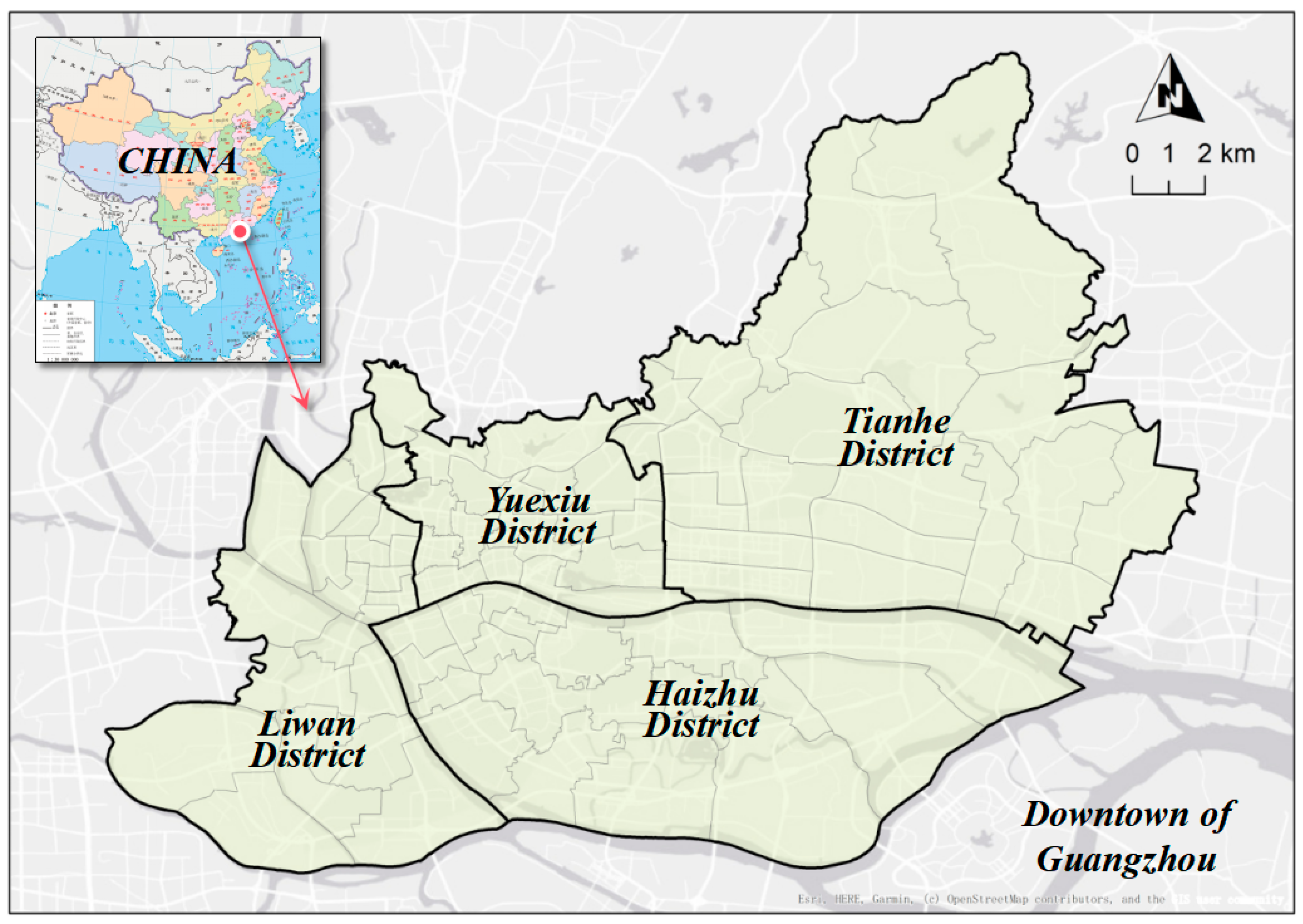
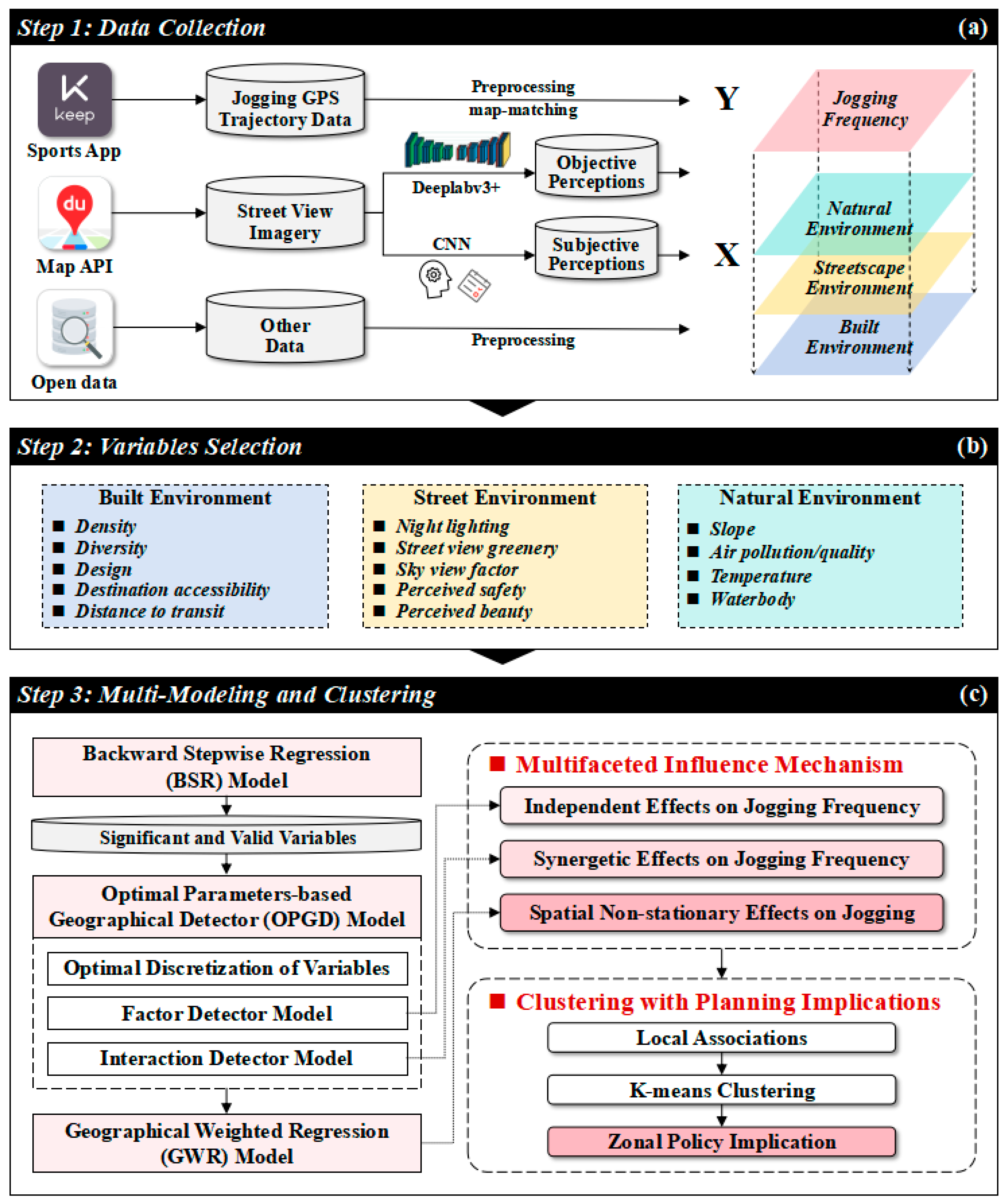



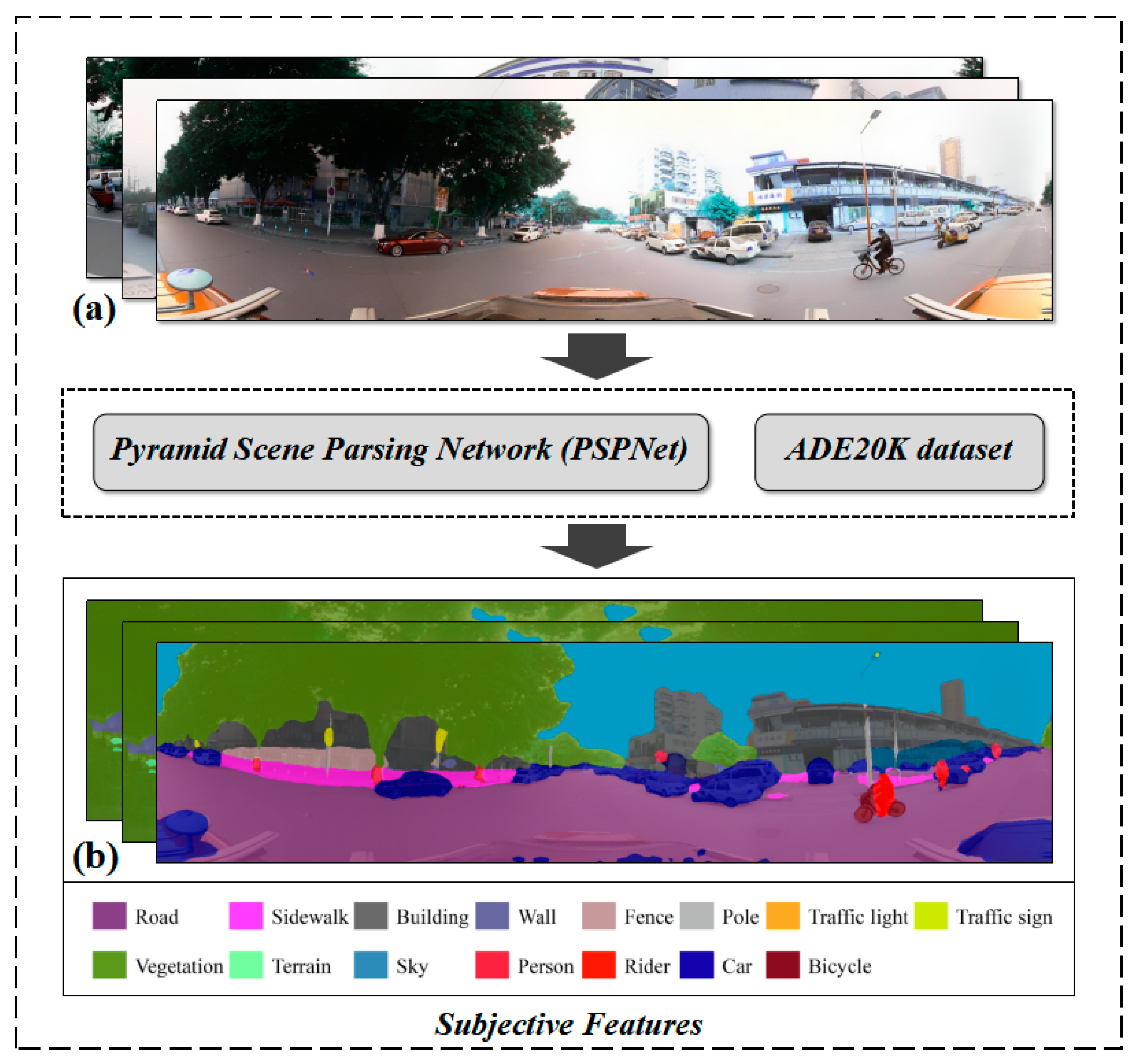
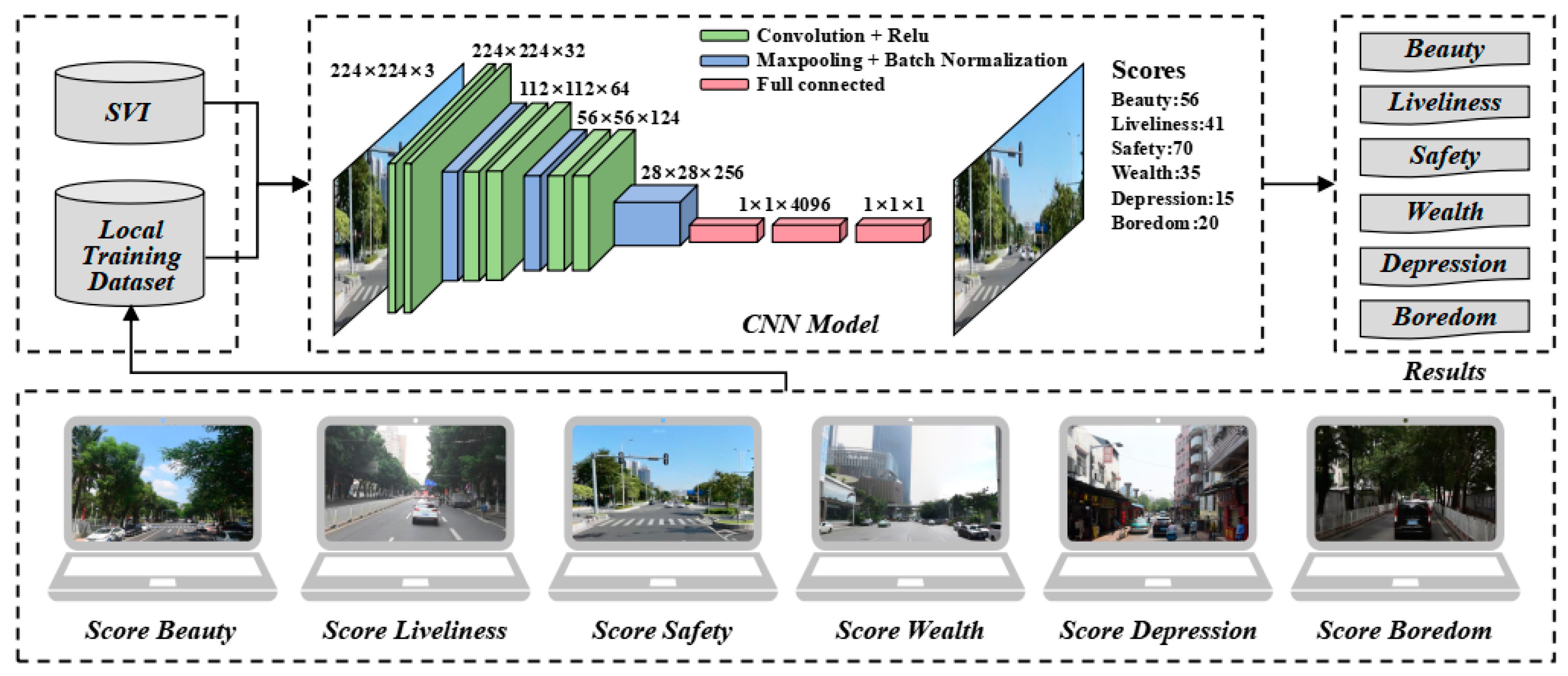
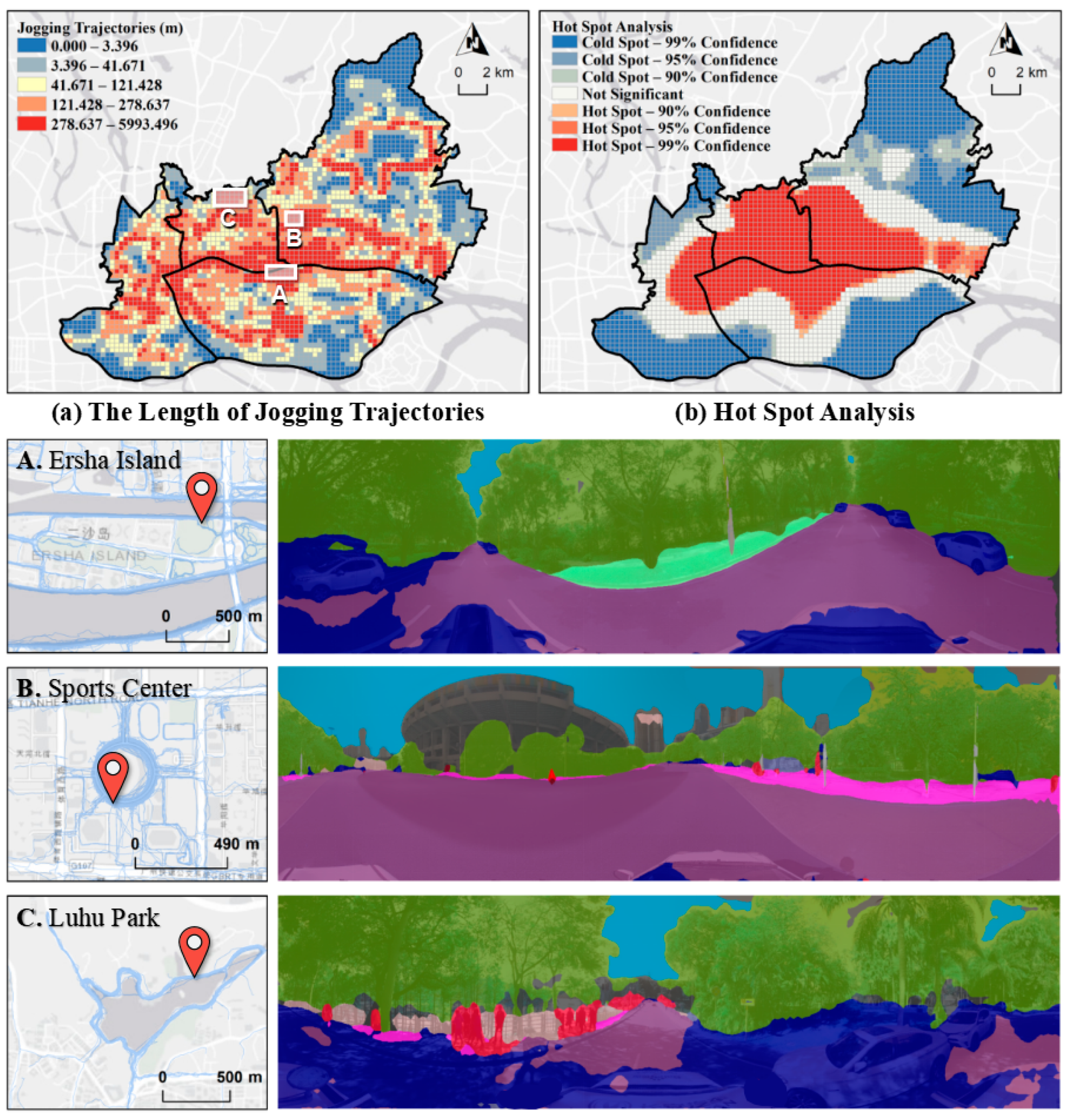
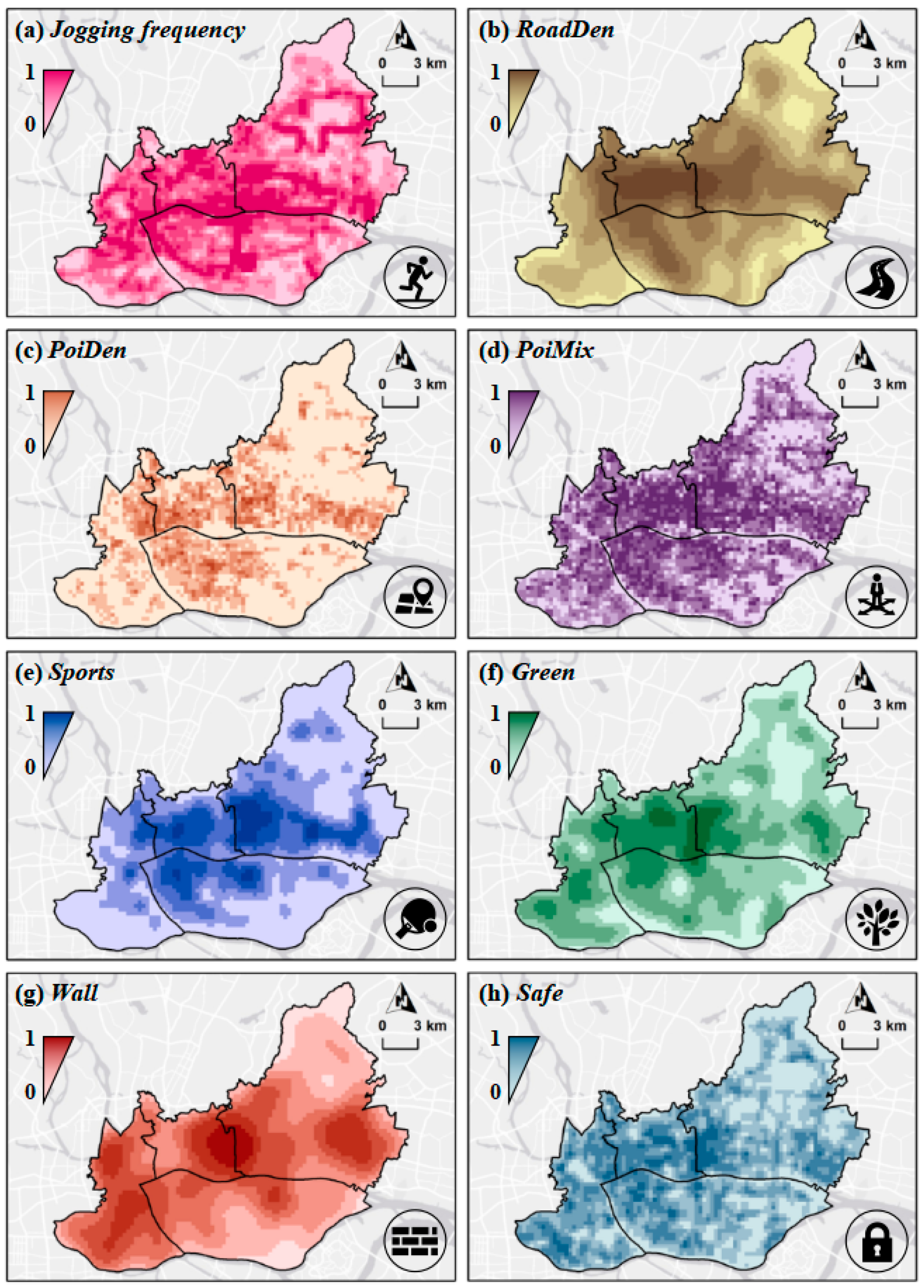
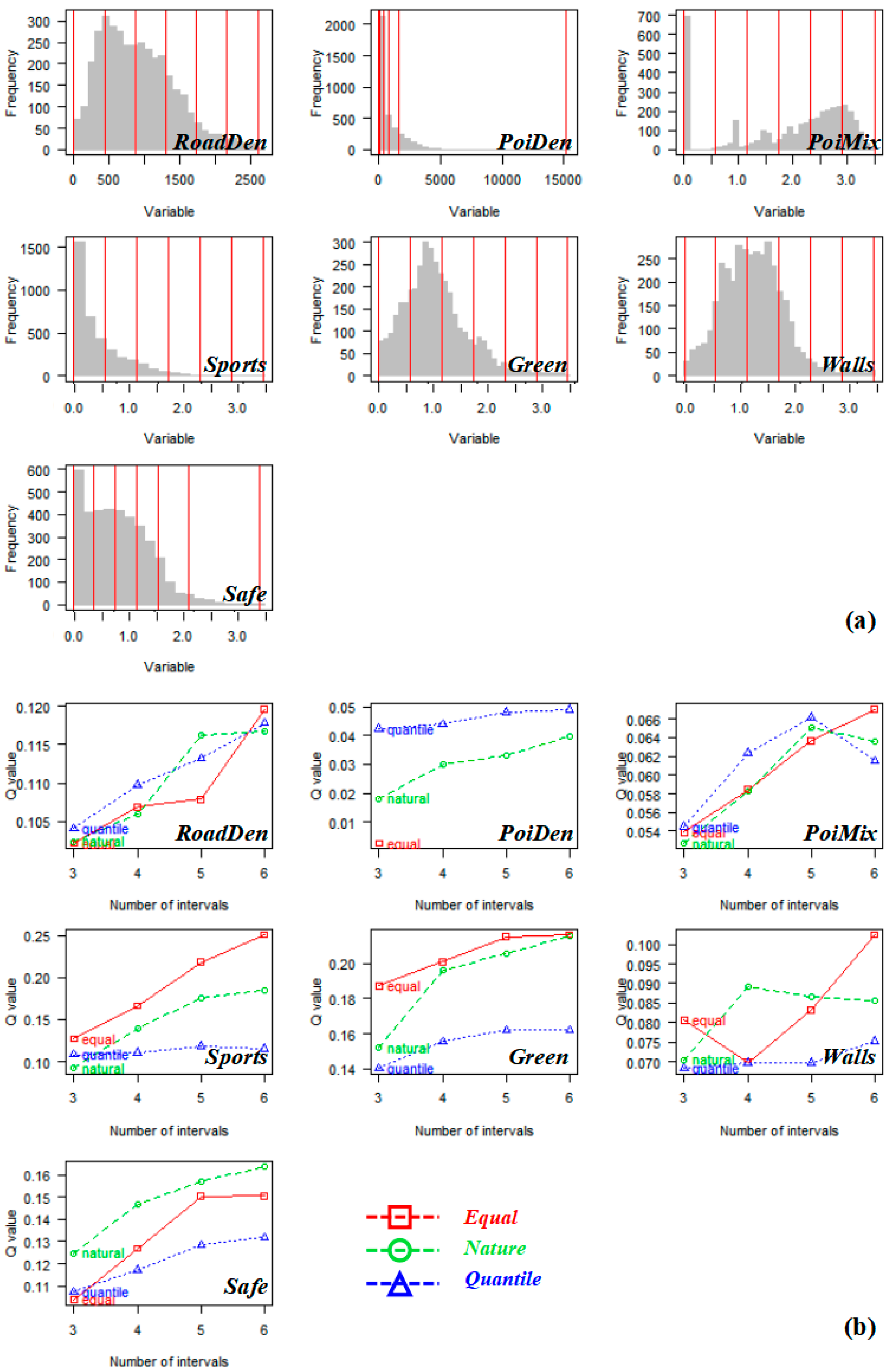

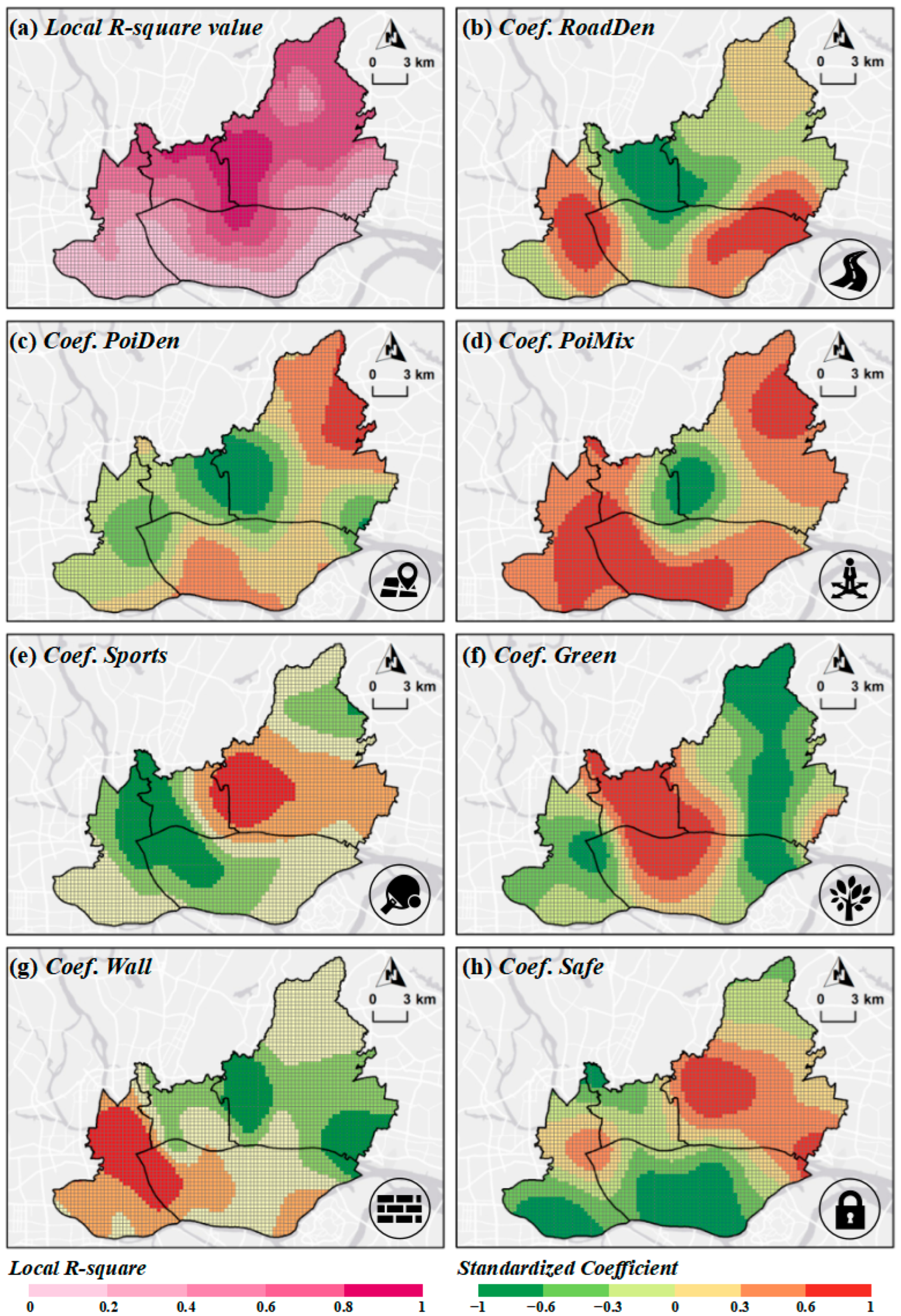
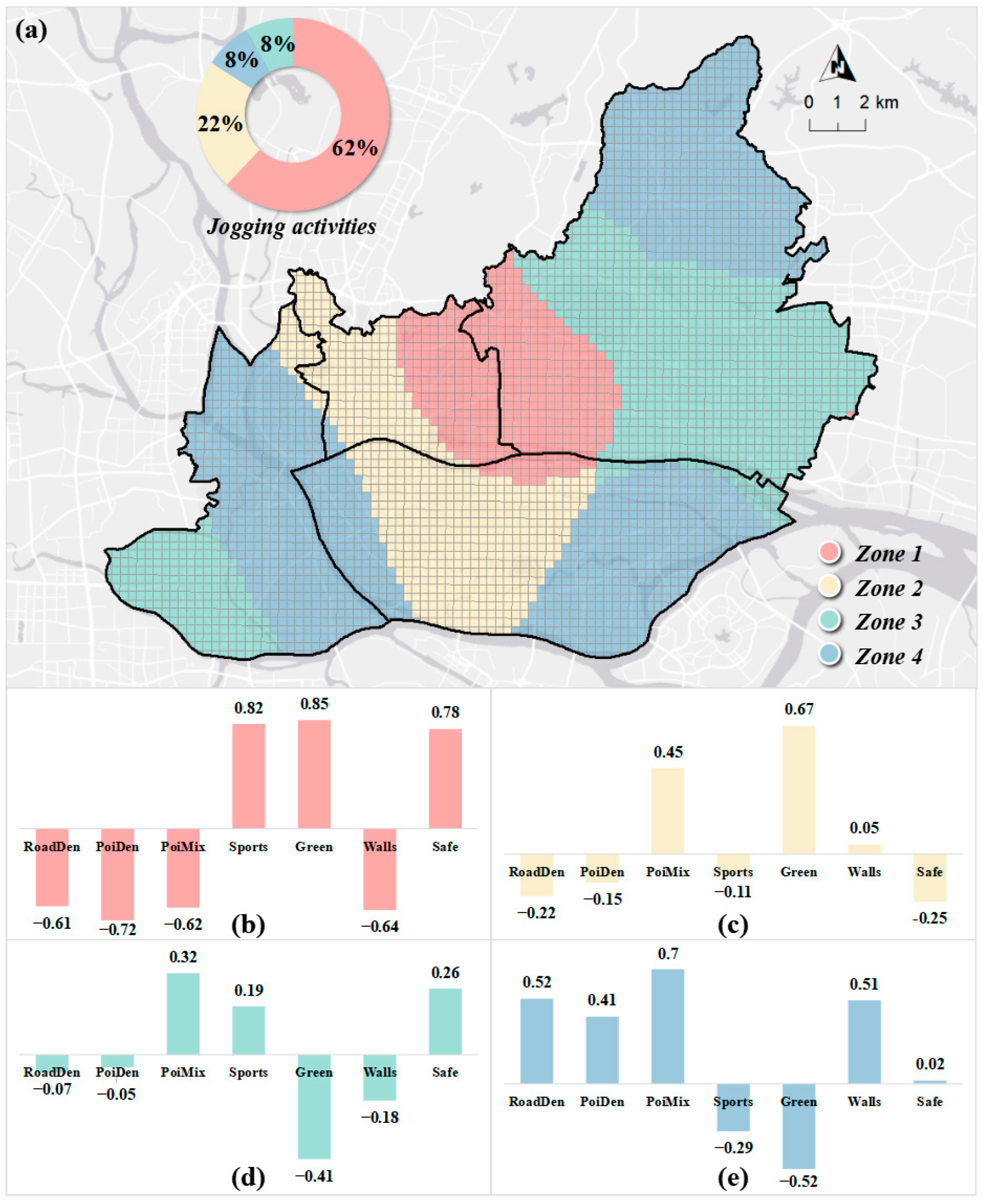
| Categories | Variables | Method/Data Source | Reference |
|---|---|---|---|
| Built Environment | Population density (PopDen) | Census data, social media user density data | [18,19,20,21,22,23] |
| Road density (RoadDen) | Road density, the angular distance-based accessibility based on Space Syntax | [18,39,40] | |
| Public transport (Trans) | Density of metro stations and bus stops | [18,20,41] | |
| Facility density (PoiDen) | Density of POIs | [18] | |
| Facility diversity (PoiMix) | Shannon entropy of POIs | [21,22] | |
| Sports facility density (Sports) | Density of sports facilities | [20] | |
| Residential density (Resi) | Density of residential communities | ||
| Park (Park) | Distance to park | [21] | |
| Nighttime lighting (NTL) | The mean DN value of NTL | [18,19] | |
| Building density (BldDen) | Total building base area divided by total area | [21,22] | |
| Street Perception | Green view index (Green) | The mean pixel ratio | [18,19,20,21] |
| Sky view index (Sky) | The mean pixel ratio | [18,19,20,21] | |
| Wall (Wall) | The mean pixel ratio | [18,19] | |
| Perceived safety (Safe) | The mean of road/grid | [18] | |
| Perceived liveliness (Live) | The mean of road/grid | [18] | |
| Natural Environment | Temperature (TEM) | Annual mean value, IDW | [22,23] |
| Air quality (AQ) | Annual mean value, IDW | [22,23] | |
| Slope (Slope) | The mean slope of road/grid | [18,19] | |
| Water (Water) | Distance to body of water /river | [20,21] |
| Categories | Variables | Mean | S.D. |
|---|---|---|---|
| Built Environment | PopDen (/km2) | 1128 | 907 |
| RoadDen (km/km2) | 906.599 | 520.972 | |
| Trans (/km2) | 8.971 | 10.056 | |
| PoiDen (/km2) | 791.006 | 1104.677 | |
| PoiMix | 0.714 | 0.694 | |
| Sports (/km2) | 4.378 | 6.047 | |
| Resi (/km2) | 28.784 | 26.012 | |
| Park (km) | 8.647 | 10.579 | |
| NTL | 0.654 | 0.457 | |
| BldDen | 0.366 | 0.285 | |
| Street Perception | Green | 0.302 | 0.172 |
| Sky | 0.233 | 0.208 | |
| Walls | 0.362 | 0.165 | |
| Safe | 0.235 | 0.167 | |
| Live | 0.224 | 0.174 | |
| Natural Environment | TEM (℃) | 32.788 | 2.658 |
| AQ () | 21.378 | 2.551 | |
| Slope (°) | 3.264 | 3.773 | |
| Water (km) | 18.103 | 20.017 |
| Categories | Variables | Coefficient |
|---|---|---|
| Built Environment | PopDen | - |
| RoadDen | 0.102 *** | |
| Trans | - | |
| PoiDen | −0.014 ** | |
| PoiMix | 0.304 *** | |
| Sports | 0.514 *** | |
| Resi | - | |
| Park | - | |
| NTL | - | |
| BldDen | - | |
| Street Perception | Green | 0.318 *** |
| Sky | - | |
| Walls | 0.211 *** | |
| Safe | 0.157 *** | |
| Live | - | |
| Natural Environment | TEM | - |
| AQ | - | |
| Slope | - | |
| Water | - | |
| Constant | 10.871 | |
| R2 | 0.582 | |
| Adj R2 | 0.574 | |
| Variables | Discretization Method | No. of Intervals |
|---|---|---|
| RoadDen | Equal | 6 |
| PoiDen | Quantile | 6 |
| PoiMix | Equal | 6 |
| Sports | Equal | 6 |
| Green | Natural | 6 |
| Walls | Equal | 6 |
| Safe | Natural | 6 |
| Rank | ) | Synergistic q Value | ||
|---|---|---|---|---|
| 1 | Sports ∩ Green | 0.477 | +90.1% | +120.4% |
| 2 | Sports ∩ Safe | 0.356 | +41.9% | +120.8% |
| 3 | Sports ∩ PoiMix | 0.346 | +37.9% | +416.4% |
| 4 | Sports ∩ Walls | 0.342 | +36.3% | +233.7% |
| 5 | Green ∩ PoiDen | 0.340 | +57.1% | +592.5% |
| Diagnostics | Global Model | Local Model |
|---|---|---|
| R2 | 0.582 | 0.653 |
| Adjusted R2 | 0.574 | 0.635 |
| AICc | 265.124 | 260.017 |
| Moran’s I (residuals) | 0.301 (0.00) * | 0.081 (0.16) |
Disclaimer/Publisher’s Note: The statements, opinions and data contained in all publications are solely those of the individual author(s) and contributor(s) and not of MDPI and/or the editor(s). MDPI and/or the editor(s) disclaim responsibility for any injury to people or property resulting from any ideas, methods, instructions or products referred to in the content. |
© 2024 by the authors. Licensee MDPI, Basel, Switzerland. This article is an open access article distributed under the terms and conditions of the Creative Commons Attribution (CC BY) license (https://creativecommons.org/licenses/by/4.0/).
Share and Cite
Shi, T.; Gao, F. Utilizing Multi-Source Geospatial Big Data to Examine How Environmental Factors Attract Outdoor Jogging Activities. Remote Sens. 2024, 16, 3056. https://doi.org/10.3390/rs16163056
Shi T, Gao F. Utilizing Multi-Source Geospatial Big Data to Examine How Environmental Factors Attract Outdoor Jogging Activities. Remote Sensing. 2024; 16(16):3056. https://doi.org/10.3390/rs16163056
Chicago/Turabian StyleShi, Tingyan, and Feng Gao. 2024. "Utilizing Multi-Source Geospatial Big Data to Examine How Environmental Factors Attract Outdoor Jogging Activities" Remote Sensing 16, no. 16: 3056. https://doi.org/10.3390/rs16163056
APA StyleShi, T., & Gao, F. (2024). Utilizing Multi-Source Geospatial Big Data to Examine How Environmental Factors Attract Outdoor Jogging Activities. Remote Sensing, 16(16), 3056. https://doi.org/10.3390/rs16163056








